
As we move into September, the warm water off the coast of Vancouver Island comes closer to shore. And with it (hands rubbing) so does the albacore tuna. Not to fear, the Island is prepared! Tuna fishing on the West Coast of Vancouver Island is becoming an immensely popular fishery. It’s fast paced, extremely exciting, and the rewards are delicious!
Who Should Go Tuna Fishing in BC?
We’d like to say everyone but this is an offshore fishery, so keep that in mind. You’ll find SFAB Off Shore Safety Guidelines at the end of this article and we do suggest that everyone reads it. Also, we’d like to recommend that you go with experienced tuna fishers. Most of the time, tuna fishing boats will travel offshore together to keep each other safe. As for crew, it really depends on the size of the boat—too many people on a crowded, wet deck can lead to accidents. Not enough people means all the lines can’t be manned, which translates to lost fish. Either way, tuna fishing can be chaotic so a good plan, experience, and good communication are big factors in your success, and your safety.
What’s Tuna Fishing Like in BC?
When you find the fish it’s non-stop action so be prepared. Be well rested, properly clothed, and equipped with redundant tackle tied, and at the ready for quick changes. If the tuna are biting on blue, switch all your gear to blue.
You’ll need to bleed and get your tuna on ice as fast as possible. You can never have too much ice, so if you think you have enough…top it up just in case. Discussing a system for dealing with fish on-board, and preparing them (bleeding and packing in ice) is an essential step before you get on the water. Often a plastic garbage can or something similar is a good plan to consider for a fish bleeding “station”. (Please refer to the SFAB Tuna Catch & Handling section at the end of this article).
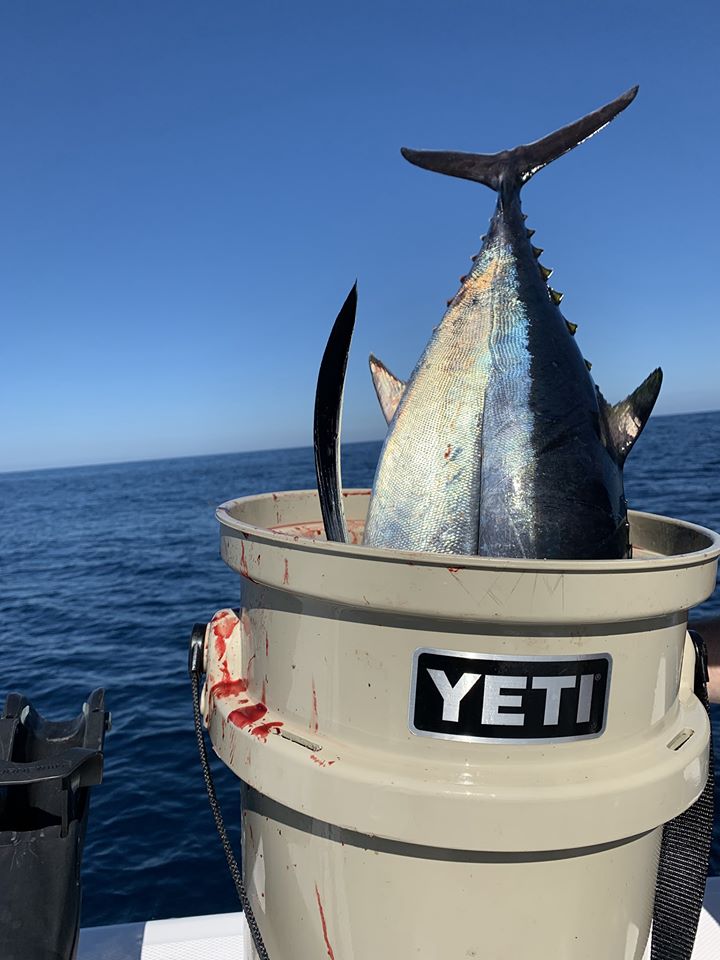
Photo courtesy Ryan Mountain – Bleeding Bucket
Running the boat means watching the water conditions, the other boats, and typically many lines (4-8 lines are common configurations depending on experience and number of crew). The last thing you want is a tangle as some of your surface lines are bouncing 80 feet behind the boat, if not more.
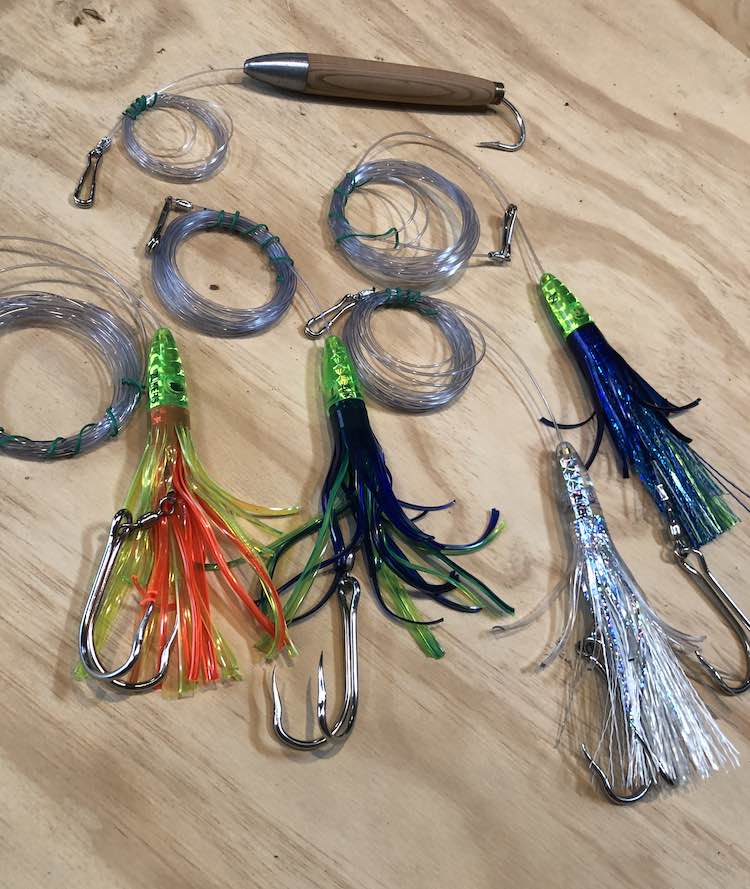
Pacific Net and Twine pre tied Tuna Lures
The most common type of fishing in our offshore tuna derbies is trolling, and trolling mainly on the surface with tuna clones (tuna specific large hoochies) and plugs, but much like our friends South of the border, jigging is catching on and is a ton of fun if you are on top of a school.

Mustad 5oz Moon Riser Jig
Trolling Setup
There are several ways of setting up a boat to troll for tuna, so Shane Gallop, Pacific Net & Twine manager, and Deryk Krefting (SFAB Tuna Chair, local fishing guide, and Pacific Net and Twine Manager, were kind enough to create the below diagram which Island Fisherman magazine redrew. (Click the diagram to download a PDF.)
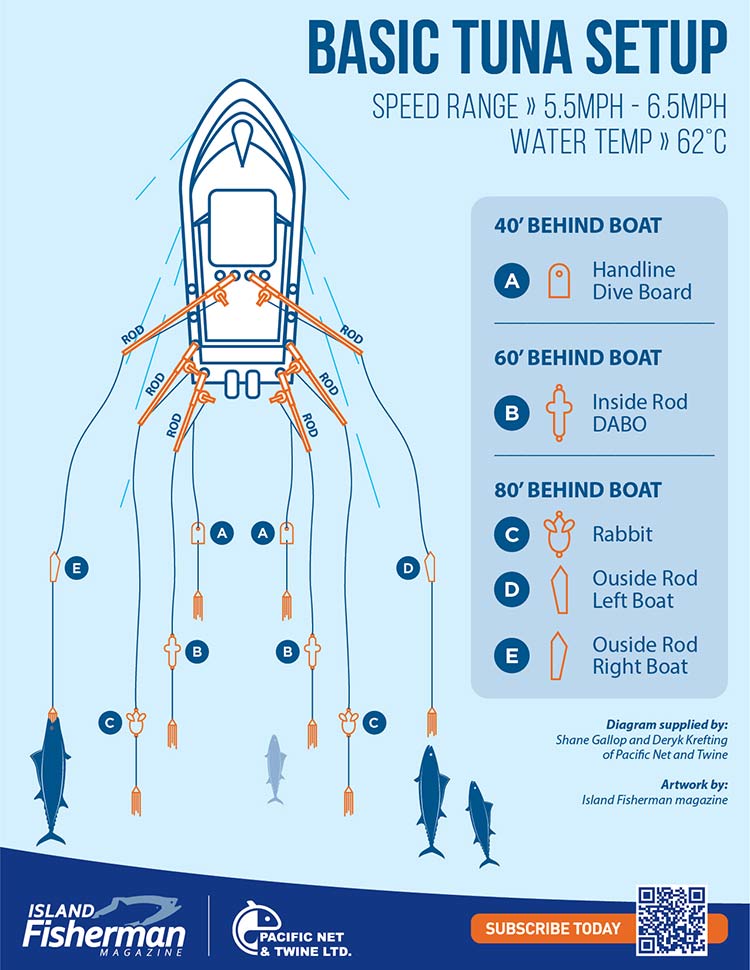
Diagram supplied by Shane Gallop and Deryk Krefting of Pacific Net and Twine, artwork by Island Fisherman magazine
You can use gear like dive boards, rabbits, DABOs, and boat boards to assist with keeping your gear on the surface, and spreading it apart.
Splashing Tuna Float
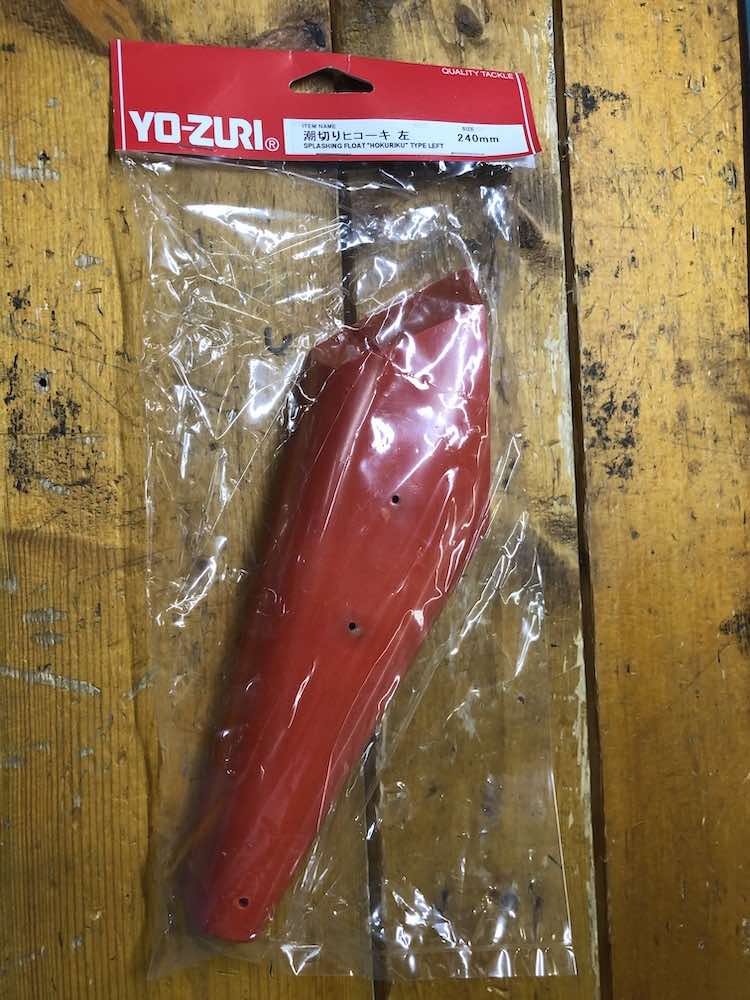
Splashing Tuna Float, photo courtesy Harbour Chandler
Tuna Trolling Rabbit with Swivel
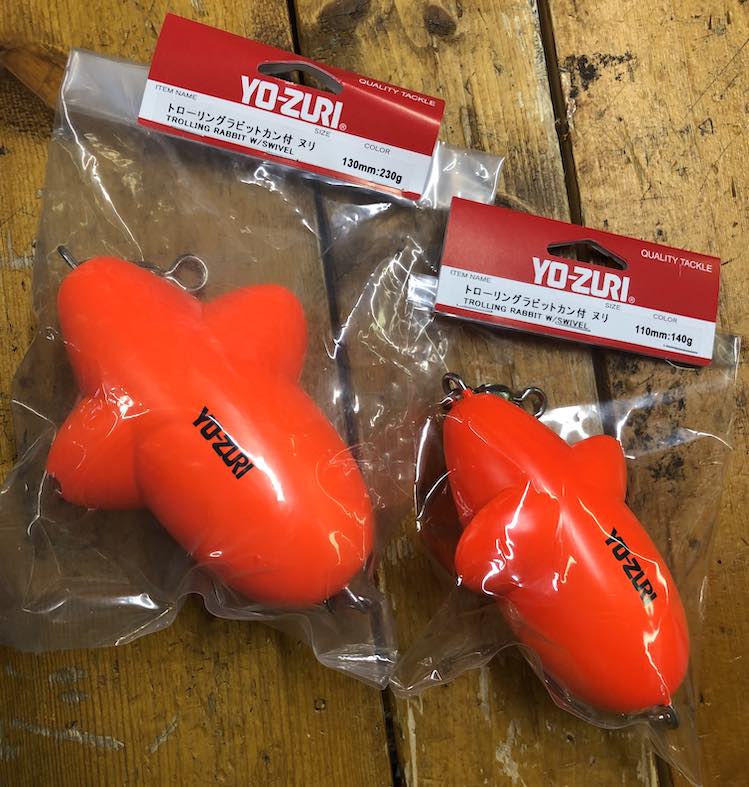
Trolling Rabbit – photo courtesy Harbour Chandler
Diving Board K Type with Swivel
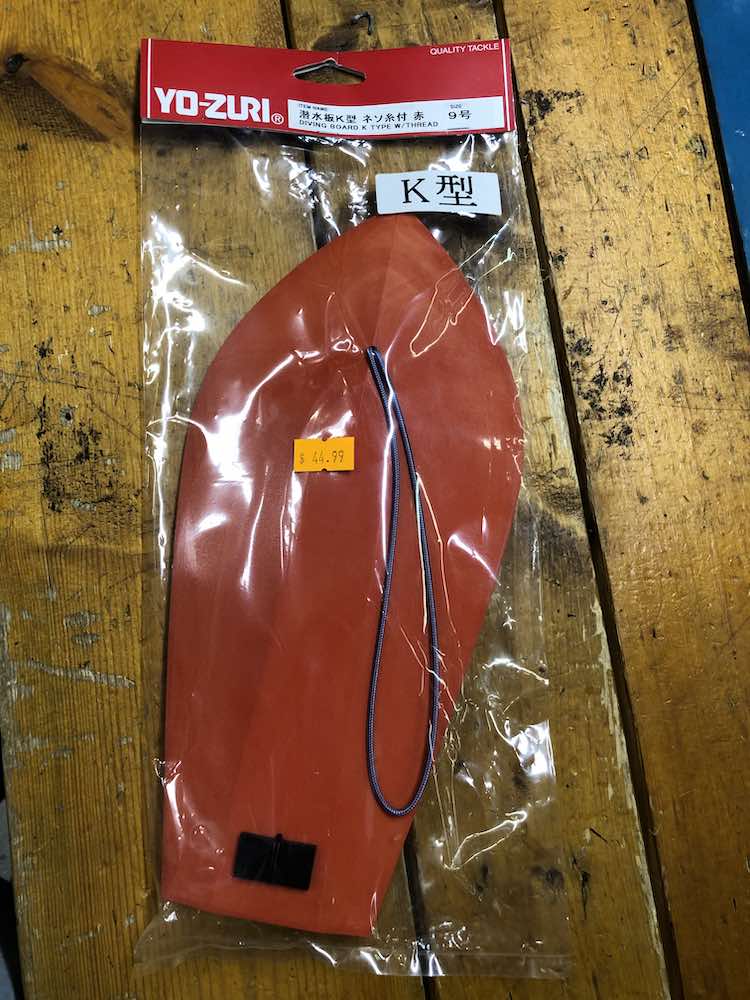
Tuna Rabbit – photo courtesy Harbour Chandler
Pole and Reel
Just like any other kind of fishing, people will suggest different configurations. For those who may only fish tuna once a while you may already have what you need—a halibut setup. For the upcoming derby, I have my 6’ 6” halibut rod (rated for 50-100 lb braid) spooled with 80 lb braid (light blue). Deryk Krefting suggests putting a 10 ft top shot of mono 10 lbs less than your main line for stretch, but it comes down to personal preference. You don’t “play” tuna anything like a salmon—you reel them in, and you reel them in fast. An Avet JK4 6:1 reel will be fine, but hey, the bigger the reel, the more line! Deryk recommends a single or two speed reel for our tuna fishery.

Rapala Benthos (6.2:1/3.3:1) & Avet JK4 (6:1)
Water Temperature Monitoring Software
If you are considering your tuna opportunity, Surface Sea Temperature (SST) is key. Look for the temperature break, where you find 59-62° F. 62° F is the perfect target.
Terrafin (https://www.terrafin.com/)
- $109.00 US/year
Ripcharts (https://www.ripcharts.com/)
- $99 year or $169 US/year for premium)
NOAA SST (https://www.ospo.noaa.gov/Products/ocean/sst/contour/index.html)
- Free, but limited
There are certainly more choices, but these are often a great place to start.
Most importantly, the Sport Fishing Advisory Board (SFAB) has put together significant information for recreational tuna fishing which we’ll highlight here, and provide as downloads in this article.
DRAFT: SFAB Offshore Safety Guidelines for Recreational Tuna Fishers (Download PDF)
Foreword
As with all fisheries, safety should always be the number one priority for every angler! Considering the distances that recreational anglers travel offshore in pursuit of Tuna, special attention should be paid to the following:
Weather
-
- Monitor the “Current” weather conditions and “forecast” prior to leaving shore, and when you are at sea. Websites such as Environment Canada ( https://weather.gc.ca ) , Unisys (http://weather.unisys.com ) and Windyty ( https://www.windyty.com ) can provide some insight, but remember the accuracy of the information can vary. When on the grounds, the weather channel on your VHF radio can provide forecast and current condition data.
- If the conditions deteriorate, have an exit plan agreed upon with your partner boats.
Stability
-
- Know your vessel’s safe weight capability; do not exceed that when loading gear, passengers and ice
- Stability – While different vessels can have varying weight capacities, it is important to know what the safe limits of your craft are. To determine what the capacity of your vessel is, it is a good idea to complete a stability test. This can be done by a naval architect, or by using the Transport Canada “Simplified Assessment of Intact Stability & Buoyancy of Small Non-pleasure Vessels”. For more information on vessel stability and conducting the assessment, consult the following Transport Canada website.
- Safely secure all items, particularly coolers to prevent load shifting
- Be aware of “Free Surface Effect” and its effect on stability
- Store items as low as possible to lower center of gravity
- For more detailed information on Marine Safety, visit https://www.tc.gc.ca/eng/marinesafety/menu.htm
Communication
-
- Monitor Channel 72 and 16; a second back up radio is a good idea
- Carry 2 VHF radios with DSC capabilities / keep a waterproof VHF radio in your ditching bag
- Contact other fishing vessels on channel 72 to notify them you are entering a fishing area – this helps increase everyone’s situational awareness
Collision Avoidance
-
- Increase visibility by utilizing flags on masts and radar reflectors
- Radar with proximity alarms and AIS is recommended
- Maintain multiple sources of navigation such as, compass, GPS chart plotter, tablet or phone
- Always keep an active wheel watch at all times – assign one driver
- Allow at least half mile distance between vessels
- Never cross in front of another vessel that is fishing
Safety / Emergency Preparedness
In addition to the standard required equipment, the following is recommended:
-
- File a detailed sail plan with a responsible shore party prior to departure, and ensure you have an agreed upon check in time and plan for notifying search authorities if overdue.
- Boats should travel together in groups of 2 or more and stay in constant contact using the buddy system for mutual safety and rescue.
- Carry and wear PFD’s. Survival suits are advisable.
- Prepare a ditching bag that holds an EPIRB flare signal kit and extra flares, first aid kit, water, waterproof flashlight.
- Conduct a pre-departure safety briefing to demonstrate all safety equipment, communication, EPIRB operation. Ensure everyone knows how to safely navigate the vessel.
- Life ring, with throw rope
- Tow rope, bridle and drone
- Carry at least 2 ABC rated fire extinguishers
- To learn more about Marine Safety, visit Transport Canada Marine Safety
Fuel Management
-
- Determine the distance you will cover prior to departure and ensure you carry enough fuel – calculate by fuel burn, anticipated speed over the distance travelled, plan for 1/3 fuel load for trip out plus fishing, 1/3 for return trip and 1/3 for reserve. Carry spare water separating fuel filters.
Maintenance
-
- Maintenance – Using a checklist, ensure that all systems on your vessel are in good operating condition prior to departure. Carry spare parts and be prepared for mechanical breakdowns.
- Having more than one source of propulsion is advisable.
SFAB Tuna Catch Handling Guidelines (Download PDF)
As Tuna tend to be warmer in temperature than the water they came from, they require special care and consideration when it comes to handling. Different procedures need to be deployed than those utilized for Salmon, Halibut and other ground fish species.
Tuna tend to contain higher amounts of “histidine” in their flesh. Histidine is a type of amino acid that is converted into “Histamine” by bacterial enzymes once the fish is deceased. The rate of this conversion is increased by temperature, so it is important that all tuna are handled properly to avoid spoilage.
The consumption of fish containing high levels of histamine can result in “scombroid poisoning”. Scombroid or Histamine poisoning often resembles an allergic reaction, and most victims recover within 24 hrs. On rare occurrence, scombroid poisoning has resulted in death.
The best way to reduce the risk of scombroid poisoning is to chill the tuna quickly after being caught!
Try following the Chilling, Icing, Freezing, Processing (CIFP) process many of the top Canadian Tuna Anglers use:
Chilling Tuna
After bleeding, chill fish in slush ice, (a mixture of two parts ice and one part seawater) before icing. Do not allow catch to lay on deck. Tuna will chill much quicker in a slurry of ice and water than on just ice by itself. This is because heat transfer from the fish occurs faster in a liquid than just ice. Remember to add ice periodically as it melts. This will also help you get the most out of your supply of ice.
Icing Tuna
Remember to take enough ice to preserve your catch. Once the Tuna has reached a core temperature of 10 degrees Celsius (use a meat thermometer) or less, pack in flake ice for no more than 5 days prior to processing. Fish should be held at 4 degrees Celsius or less. Fish should be iced in single layers with ice between each layer. Add ice to the top of the cooler or hold (cap icing).
Freezing Tuna
If you are unable to process your catch immediately, freeze your catch as soon as possible.
Processing Tuna
Now that you have caught, chilled and cared for your Tuna, the next step is to properly package your catch for long term preservation.
Anglers can either fillet their catch into loins and vacuum seal and freeze themselves, or have it processed (canned or other) by a licenced processing facility. If you choose to can the fish yourself, it is advisable to check the CFIA and USFDA websites for proper practices and techniques.
Always keep fish cold until you process the catch yourself or deliver to a processing facility. Remember to check with the processing facility for their specific guidelines, as many companies have their own specific policies which may vary from different service providers.
Albacore tuna fishing on the West Coast of Vancouver Island is just another of the many world class fishing opportunities you’ll experience here in paradise. John Falavolito, our resident Esperanza Inlet Area Reporter and the Owner/Operator of Westview Marina in Tahsis, said it best in the September 2020 Issue of Island Fisherman magazine. “The local tuna fishers say—it is the most fun you can have in a boat with your clothes on!”
Never miss an issue of Island Fisherman magazine—subscribe today!
Visit the Store
$34.99
$34.99
Featured Catch

Joel Unickow halibut (Photo: Rob Frawley Lucky Strike Sportfishing Tofino)







